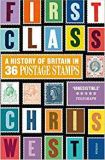First Class: A History of Britain in 36 Postage Stamps by Chris West
| First Class: A History of Britain in 36 Postage Stamps by Chris West | |
|
| |
| Category: History | |
| Reviewer: John Van der Kiste | |
| Summary: A history of Britain from 1840 to the present day as seen by the author, through (mostly) British stamps, the events and the eras which they commemorated or in which they were issued | |
| Buy? Yes | Borrow? Yes |
| Pages: 257 | Date: October 2012 |
| Publisher: Square Peg | |
| External links: Author's website | |
| ISBN: 9780224095464 | |
|
| |
As a philatelist and lover of history, I approached this book with even more curiosity than usual. The subtitle suggested a very intriguing approach, but would it work? I’m glad to report that it did.
The author inherited both the same interests at an early life from members of his family, before they gave way to the usual teenage passions like The Beatles and girls, but he has returned to them in more recent years. The result is an absorbing wander through British history from Rowland Hill’s introduction of the penny post in 1840 and the advent of the 1d. black, to Olympic Britain and the summer of 2012. 36 different stamps provide the focus, or the background, for different chapters or milestones in the story.
The first few to be featured are various Queen Victoria definitives with sober and, with the exception of the 1887 'Jubilee' set, one-colour designs that are truly from a different world - although it can be argued that the Queen Elizabeth II Machin definitive, introduced in 1967 and retained with only minor variations for almost half a century and counting, is in its own way just as classic and simple a design as some of the earlier issues.
I like the way that West takes a specific stamp and uses it as a peg on which to hang a particular set of events, or a brief era. The humble 1d. lilac of 1881, of which 33 billion were produced, heads a chapter on social England and the nation’s achievements around that date, such as the domination of the political scene by Gladstone and Disraeli (who died that year), the FA Cup Final at Kennington Oval, and the peak years of Gilbert & Sullivan and the Savoy Operas. Moving on a generation or so, the 1d. Red of 1916 prefaces several pages on the tragedy of the Great War, and what it meant for the humble soldiers and the families to which many of them would never return.
With two exceptions, the stamps featured are British. One of the overseas exceptions is the Hong Kong 5c. blue of 1892, from the height of the British Empire – as good an example as any of the territories on which the Victorians loftily believed at the time the sun would never set. The other is the German 200m. red of 1923, overprinted 2,000,000m, a sober reminder (with a very boring design, frankly) of what happened when financiers and politicians lost control of the economy, and people took their currency in wheelbarrows to go shopping, turned their backs on it then found their worthless money piled up on the pavement but the barrow missing.
On occasion we are treated to fascinating stories about the stamps, their history and origins. The Edward VIII set of four issued in 1936 during the months before his abdication are a case in point, having been designed by a Devon schoolboy, Hubert Brown, and sent to Harrison & Sons, the Post Office printers. The next thing he knew was that the stamps were on sale, and his father complained, only to be told by the Post Office that they had actually designed them themselves. Mr Brown Senior kept up a valiant fight, and at length a credit in the Stanley Gibbons catalogue acknowledged his son’s artistry, ‘adapted by Harrisons’. Personal comment slips in here and there, as West remarks that the striking 1s.3d. Coronation stamp of 1953 showing Queen Elizabeth II full face in her regalia was ‘magnificent’. 27 years later, the 12p. issue marking the 150th anniversary of the Liverpool and Manchester railway was appropriate as it celebrated a classic piece of commercial entrepreneurship much in keeping with what the new Prime Minister of the time so admired. He also observes that, ironically, on the 16p. 2nd European Elections design of 1984, the bull is looking one way and the rider the other. Intentional or not, it was an apposite judgment on Britain’s equivocal relationship with the mainland continent.
Regrettably, these stamps are not the commonplace adornment of our letters or cards that they were thirty years ago or more, and the ubiquitous franking machine as well as the Post Office’s beloved gold-coloured parcel label between them must take a good deal of blame for the decline of philately. In the penultimate chapter, West notes the ‘strange, postmodern artificiality’ of new issues being confined to mini-sheets, generally costing over £3, to be retained lovingly as keepsakes. One prime example was that for the royal wedding of 2011. Is it any wonder that few if any of us purchased one because we planned to split it and use one stamp at a time on ordinary letters and postcards, with the result that many of us probably never even saw it except as part of a display in our local Post Office? However, in the brave new world around us of e-mail and texting, we might ask - what letters and postcards.
On the last page of the book, we are left wondering how a set of modern stamps will appear in 2100. Few of us will be around by then to see whether the postage stamp has gone the way of the record player or the videocassette recorder. Nevertheless, for the time being, this is a thoroughly entertaining, well-designed journey through the last 170 years or so, with the historical and philatelic incursions providing added interest. First class? Yes, definitely.
If this book appeals thenyou might also be interested in:
Stanley Gibbons Stamp Catalogue 2013: Commonwealth and Empire Stamps 1840 - 1970 by Hugh Jefferies
Please share on: ![]() Facebook,
Facebook, ![]() Twitter and
Twitter and
![]() Instagram
Instagram
![]() You can read more book reviews or buy First Class: A History of Britain in 36 Postage Stamps by Chris West at Amazon.co.uk Amazon currently charges £2.99 for standard delivery for orders under £20, over which delivery is free.
You can read more book reviews or buy First Class: A History of Britain in 36 Postage Stamps by Chris West at Amazon.co.uk Amazon currently charges £2.99 for standard delivery for orders under £20, over which delivery is free.
![]() You can read more book reviews or buy First Class: A History of Britain in 36 Postage Stamps by Chris West at Amazon.com.
You can read more book reviews or buy First Class: A History of Britain in 36 Postage Stamps by Chris West at Amazon.com.
Comments
Like to comment on this review?
Just send us an email and we'll put the best up on the site.


